Inside The New York Botanical Garden
Archive: November 2009
Posted in Gardening Tips on November 30 2009, by Sonia Uyterhoeven
 |
Sonia Uyterhoeven is Gardener for Public Education. |
Last week I blogged about the causes of late blight. This week we’ll look at ways to deal with it and other fungal diseases in general.
Here at the Garden, we thought we had missed the late blight since we made it through the initial onslaught unscathed. The problem with fungal spores is that some of them love to hang around. In late August we went out into the garden on a Monday after a heavy weekend rain and found a number of plants covered with white powdery spots.
On further inspection we found signs of brown lesions on stems, and several of the leaves were starting to darken into brown spots. Since this fungal problem progresses so rapidly, we decided that we wouldn’t wait to get the problem plants tested. I spent an afternoon filling garbage bags with diseased tomato plants, carefully cutting them up piece by piece so as not to unwittingly spread spores all over the place. Even for compost aficionados, it is advised to toss diseased plants into the trash rather than risk the disease surviving the composting process and infecting new areas of the garden.
After I disposed of the wreckage, I went back into the garden and doused the remaining tomato plants with a product called Plant Health Care Biopak Plus. It is a micronutrient treatment with beneficial bacteria that supports plant vigor (it is similar to spraying the plants with compost tea to protect them).
Read More
Posted in Exhibitions, Holiday Train Show, Programs and Events on November 25 2009, by Plant Talk
View Holiday Train Show, Ex Libris Exhibition, and More
Before sitting down to turkey and stuffing, come enjoy the bounty of the Garden, which is open on Thanksgiving Day this year, from 10 a.m. to 6 p.m. The Garden will have extended hours for the remainder of the weekend for your enjoyment, relaxation, and gift shopping: from 10 a.m. to 7 p.m., Friday through Sunday, November 27–29.
Weekend highlights include:
- Holiday Train Show —Step into a seasonal wonderland in the Conservatory.
- Gingerbread Adventures —Marvel at the kid-sized gingerbread house and decorate gingersnaps in the Everett Children’s Adventure Garden.
- Ex Libris: Treasures from the LuEsther T. Mertz Library —See botanical books and artistic treasures never before exhibited to the public in the Rondina and LoFaro Gallery.
- 250 acres of fall beauty—Catch the end of autumn’s colorful display in the gardens and Native Forest.
- Holiday shopping and lunch—Find wonderful gifts for everyone on your list at Shop in the Garden and then grab lunch or a snack at one of our two Cafes.
The New York Botanical Garden is thankful for your patronage and support. Come share the day and the long holiday weekend with us, and have a Happy Thanksgiving!
Get Your Tickets
Shop |
Posted in People on November 25 2009, by Plant Talk
Garden Honors Those Who Served in Record Numbers
 Carol Capobianco is Editorial Content Manager at The New York Botanical Garden.
Carol Capobianco is Editorial Content Manager at The New York Botanical Garden.
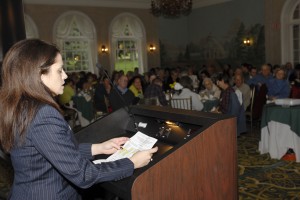 Earlier this year both Mayor Bloomberg and President Obama issued a call to action, encouraging New Yorkers and all Americans to volunteer in their communities.
Earlier this year both Mayor Bloomberg and President Obama issued a call to action, encouraging New Yorkers and all Americans to volunteer in their communities.
Many regarded the call and came to volunteer at The New York Botanical Garden in record numbers during a challenging year for cultural institutions. They contributed to every program, project, and department, helping to ensure that, alongside staff, the Garden would rise above financial obstacles.
Margaret Horgan of the Throgs Neck section of the Bronx heeded the words of the Mayor and President and in June became a volunteer for the first time in her life—choosing the Garden as the place she’d give of her time. Here, as a newcomer, she is open to whatever is asked of her, from stuffing envelopes to greeting visitors.
“I try just about everything and anything,” said Margaret, who also credits her neighbor’s influence for finally getting involved 10 years after retiring as an administrative assistant. “I’m a Bronxite, and I love the Garden; it’s a gem. I wanted to give something back.”
 Margaret is one of many first-time volunteers the Botanical Garden welcomed this year and one of a record 1,109 people who gave 84,000 hours, playing a major role in making the Garden a special place to visit. She was among those present at this year’s annual lunch reception, which honors, praises, and thanks Garden volunteers for their generous service.
Margaret is one of many first-time volunteers the Botanical Garden welcomed this year and one of a record 1,109 people who gave 84,000 hours, playing a major role in making the Garden a special place to visit. She was among those present at this year’s annual lunch reception, which honors, praises, and thanks Garden volunteers for their generous service.
Read More
Posted in Shop/Book Reviews on November 24 2009, by Plant Talk
 |
Stephen Sinon is Head of Information Services and Archives in The New York Botanical Garden’s LuEsther T. Mertz Library. |
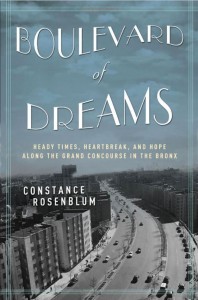 The Grand Concourse, stretching over four-and-a-half miles in the Bronx, is one of New York City’s lesser known architectural delights. Now its political and social history is the subject of a new book, Boulevard of Dreams: Heady Times, Heartbreak, and Hope along the Grand Concourse in the Bronx, by New York Times City Desk editor Constance Rosenblum.
The Grand Concourse, stretching over four-and-a-half miles in the Bronx, is one of New York City’s lesser known architectural delights. Now its political and social history is the subject of a new book, Boulevard of Dreams: Heady Times, Heartbreak, and Hope along the Grand Concourse in the Bronx, by New York Times City Desk editor Constance Rosenblum.
The thoroughfare, modeled after Paris’s Champs-Élysées, was completed in 1909 and saw the arrival of many Art Deco structures housing upwardly mobile Jews in the first five decades of the 20th century, followed by waves of Irish and Italian immigrants.
While Rosenblum explores various aspects of Jewish communal life near the boulevard, she also dissects the rivalry between the affluent West Bronx and the working-class East Bronx, and the racial tensions that led to white suburban flight and the decline and neglect of the area. The first major book to document the rise, fall, and current revival of this century-old Bronx landmark is a must-read for those interested in the cultural history of New York City, urban history, Jewish-American life, and yes, even baseball and the Lindbergh baby kidnapping.
Read More
Posted in Gardening Tips on November 23 2009, by Sonia Uyterhoeven
 |
Sonia Uyterhoeven is Gardener for Public Education. |
I think it is worth reflecting further on the effects of the cool, rainy weather we had this season—not to reminisce but rather to attain a deeper understanding of the practice of gardening.
Something came along this year that caught people by surprise. Late blight (Phytophthora infestans) swept through the region like a hurricane and caught everyone off guard by acting like an awkward party guest who arrived early.
Meteorologically, its early appearance was logical. Late blight is a devastating fungal problem that thrives with high humidity and cool, rainy weather. It covers a plant with white powdery spores and large green to brown spots that swell to the size of a quarter. The stem is typically marked with brown lesions. This fast-moving disease can decimate a plant within a week.
In the New York area, one of the disease’s greatest targets, tomatoes, are generally planted between Mother’s Day and Memorial Day, when the temperatures are warming up. It is generally only late in the season when they are susceptible to cool, rainy temperatures.
Read More
Posted in Exhibitions, Holiday Train Show, Uncategorized on November 20 2009, by Plant Talk
Excitement Builds Waiting to See Show for First Time
 |
Laura Collier is Marketing Associate at The New York Botanical Garden. |
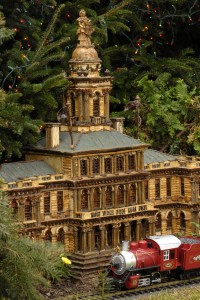 Ah, yes. The first month of a new job. So many exciting possibilities, but also so many questions! I just moved to New York City and just started at The New York Botanical Garden, so there certainly is a lot to learn. Since my first day, I’ve been happy to be thrown right into the mix, learning quickly about the Garden, the events, collections, location of the lunchroom—the general “first-week 101.”
Ah, yes. The first month of a new job. So many exciting possibilities, but also so many questions! I just moved to New York City and just started at The New York Botanical Garden, so there certainly is a lot to learn. Since my first day, I’ve been happy to be thrown right into the mix, learning quickly about the Garden, the events, collections, location of the lunchroom—the general “first-week 101.”
It’s an especially busy time here, preparing for the huge Holiday Train Show, which opens this weekend. It’s been interesting to see how much the staff and volunteers look forward to this event. Whenever someone mentions the Holiday Train Show, their voice changes a bit. When they find out that I’ve never been to the show, they immediately drop what they are doing to tell me about how beautiful the Conservatory looks when it’s all decorated and lit up or about their favorite landmark replica, like Yankee Stadium or the Brooklyn Bridge. Maybe they even mention that they secretly like The Little Engine That Could™ Puppet Show and that they are glad to have a 3-year-old nephew to use as an excuse to see it again this year. (Don’t worry; your secret is safe with me.)
Read More
Posted in Shop/Book Reviews on November 19 2009, by Plant Talk
Designer of NYBG’s Rose Garden a Real “Artist and Hero”
 John Suskewich is Book Manager for Shop in the Garden.
John Suskewich is Book Manager for Shop in the Garden.
 In Beatrix Farrand: Private Gardens, Public Landscapes, Judith Tankard avoids the pitfall of turning a historical figure into a waxwork and brings to life this pioneering woman who was one of the first important American landscape gardeners. As someone who designed an important feature of The New York Botanical Garden, the magnificent Peggy Rockefeller Rose Garden, Beatrix Farrand (1872–1959) is of particular interest to us here.
In Beatrix Farrand: Private Gardens, Public Landscapes, Judith Tankard avoids the pitfall of turning a historical figure into a waxwork and brings to life this pioneering woman who was one of the first important American landscape gardeners. As someone who designed an important feature of The New York Botanical Garden, the magnificent Peggy Rockefeller Rose Garden, Beatrix Farrand (1872–1959) is of particular interest to us here.
Hers is a great “little Old New York” story. Farrand’s aunt was Edith Wharton, she herself was one of Mrs. Astor’s “Four Hundred,” and Henry James was often a household guest, so she could have coasted. Instead, to a great talent Farrand added diligent study and travel, hard work, a facility for networking, and—for that time and place—a kind of courage. The commissions she attracted after 1900 included some of the most notable country places of that era: Crosswicks in Pennsylvania; the Fahnestock estate in Lenox, Massachusetts; Bellefield, the Newbold family property in Hyde Park, New York; and a slew of blue-blooded landscapes on Long Island.
The author’s chapter on Farrand’s assignment at The New York Botanical Garden is especially noteworthy. This involved creating an elegant design for a public rose garden out of a tricky site while developing a collection of roses that would have aesthetic and educational merit. The ups ands downs and ups of this rose garden reflect in a way NYBG’s own story, and of the difficulties that make landscape gardening such a complicated art, as time takes its toll. But time also tells, and in a volume that contains pages of marvelous photography, this garden is beautifully pictured, here and now, in its current state of grandeur.
Read More
Posted in People, Science on November 17 2009, by Plant Talk
Staffer Discovers Home, Resting Place of NYBG Founders on Staten Island
 |
Lisa Vargues is Curatorial Assistant of the Herbarium. |
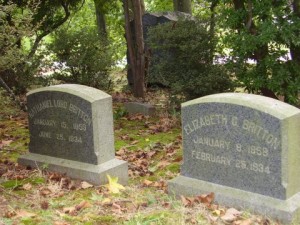 In honor of the 150th birthday this year of Nathaniel Lord Britton (1859–1934), who with his wife, Elizabeth Gertrude Britton (1858–1934), founded The New York Botanical Garden, I set out to retrace some of his footsteps. My pursuit provided further insight into his life and brought some fascinating places to light.
In honor of the 150th birthday this year of Nathaniel Lord Britton (1859–1934), who with his wife, Elizabeth Gertrude Britton (1858–1934), founded The New York Botanical Garden, I set out to retrace some of his footsteps. My pursuit provided further insight into his life and brought some fascinating places to light.
This spark of nostalgic curiosity came over me ever since I started working on the Flora Borinqueña Digital Herbarium and Library, a project that makes available online the unpublished manuscript of the popular flora of Puerto Rico— along with images of related specimens—that Britton was working on at the time of his death.
After more than 70 years, Britton’s final manuscript emerged from storage, and in a Rip van Winkle moment has been resurrected in a brand new era of computers and digitization. Ironically, Britton was resistant to installing electricity (“an unnecessary luxury”) in the Garden’s Museum building (now the Library building), and instead frugally worked by gaslight, according to The New York Botanical Garden: An Illustrated Chronicle of Plants and People.
While transcribing some of Britton’s last written words in the Flora Borinqueña, including his shaky handwritten marginal notes, I wondered where the Brittons’ final resting place is and whether there are any remnants of their life here in New York, outside of the Garden.
And so my search began.
Read More
Posted in Gardening Tips on November 16 2009, by Sonia Uyterhoeven
 |
Sonia Uyterhoeven is Gardener for Public Education. |
In the gardening world we all talk about “cultural care” and nod our heads knowingly: Growing requirements for vegetables include full sun, proper spacing, good drainage, and some kind of soil amendment, preferably organic material. We know the drill.
Being human, however, we often cut corners and hope for the best. Plants tend to be fairly accommodating—they grow in spite of everything we do to them—and often we walk away feeling like a success.
This year, however, the weather was so inhospitable that any corners cut turned into messy gaps in the garden.
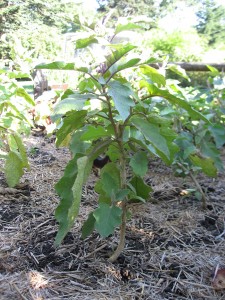 It was a miserable year for the “fruiting” vegetables such as peppers, eggplants, and tomatoes—at least in my garden. The warm-season crops sulked or came to a screeching standstill early in the season when June decided it was April and summer went on an extended leave of absence.
It was a miserable year for the “fruiting” vegetables such as peppers, eggplants, and tomatoes—at least in my garden. The warm-season crops sulked or came to a screeching standstill early in the season when June decided it was April and summer went on an extended leave of absence.
In one part of the garden we planted young transplants of peppers and eggplants in early June as is our common practice. The cool temperatures stunted their growth and these vegetables never entirely recovered (see photo at right). Why? They were planted in an area that is not blessed with full sun. With all the rain, the soil stayed cool and excessively moist for half the season.
Read More
Posted in Exhibitions, Kiku on November 13 2009, by Plant Talk
Final Year of Incredible Chrysanthemum and Japanese Garden Displays
Kiku in the Japanese Autumn Garden showcases more than 5,000 kiku (chrysanthemums) meticulously displayed in traditional Japanese styles. This last weekend—the exhibition is in its third and final year—step into the brilliant colors of a Japanese garden: kiku in full bloom, Japanese maples a deep red; and the Garden bustling with activities.
Don’t miss these highlights:
- The taiko Japanese drum is believed to be entertainment for the gods. You’ll be in good company as you enjoy a thrilling drumming presentation by Taiko Masala on Saturday and Sunday at 1 and 3 p.m.
- Japanese Autumn Adventures in the Everett Children’s Adventure Garden offers hands-on fun for the whole family. This weekend children can slip on a kimono and enjoy a tea ceremony.
- Take part in Home Gardening Center demonstrations of Japanese gardening techniques and docent-led tours of the Kiku exhibition.
Get Your Tickets |















